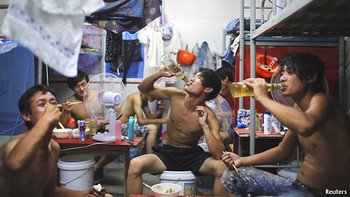酔っ払い天国ー中国 [海外]
アルコール天国ー中国

★イギリスの経済誌エコノミスト8月9日号は中国人のアルコールを飲む量が増えてきて今後中国で大きな社会問題になるだろうと論評しています。
かつては日本が「酔っ払い天国」などと言われていましたが、今度は中国がGDPのみならず、アルコール摂取量でも日本を追い越す勢いです。
「記事内容」
勤務中、休憩時間にビールを飲む中国人
山東省出身の建設従業員リー・ジュンさんは歩道上に座り込み、職場の同僚たちとヤンジンビールの大瓶をちびりちびり飲み、麺料理をみんなで一緒に食べている。
「こんな暑い日にはビールを飲むのか゛一番。飲んでるときは休んでいるから昼食時に酒を飲んでも大丈夫。」と言う。職場の仲間たちもほとんどビールを楽しんでいる。
アルコール摂取が健康に与える影響についての認識度は中国では驚くほど低い。
何世紀にわたって中国人はお祝いの席ではお酒を飲んで楽しんできたが、日常生活の中で酒を飲む人はあまりいなかった。
収入アップにつれて酒の量もアップ
この35年間で中国人の収入が上がるにつれて、中国人のアルコール摂取量は急激に増えてきた。
中国人1人当たりの平均年間摂取量は1976年の2.5ℓから2010年には6.7ℓにまで増大した。その70%近くががウイスキーやブランデーなどの蒸留酒だ。
つい最近までは適度の飲酒が社会的通念として好まれていて、アルコールを飲むのは食事の時がほとんどであり、独りで飲む人はまずいなかった。
アルコールを飲む女性はまれで、若者たちは飲むのを控えていた。
国際的レベルから見ても中国人のアルコール摂取量はまだまだおとなしい方だ。
世界保健機構によるとドイツ、フランスと比べてもほぼ半分の量となっている。
中国人の半数は禁酒主義者であるが、アルコールを頻繁に飲む人は徹底的に飲む。
危険度の高い飲み方はいたるところに蔓延している。
酒の付き合いは出世に必要不可欠
中国では仕事の得意先や同僚と飲むのは出世には欠かせないという風潮がある。
公務員は一般の人よりもアルコールに関係した肝臓病を発症する危険性が高い(地位が高くなればなるほど健康を害する度合いが高くなる)という調査結果もある。
このようにして中国では年齢とともにアルコールを飲む量が増えていく傾向にあるが、ヨーロッパや北アメリカでは20代前半がピークなのとは対照的だ。
今や中国では若い人も酒を飲むようになってきた、しかも食事を取らないで飲むことが多いという。さらには女性も酒を飲む量が増えてきている。
中国政府の対応策
中国政府は2011年5月に飲酒運転の取締りを行い、罰則を強化した。その結果、飲酒運転事故はこの2年間で40%近くも減少している。
習 近平国家主席の汚職撲滅運動によりこれまでの豪華な宴会も控えるようになった。
このおかげて高級ブランドの酒がすごく安く買えるようになったという。
様々な問題点
政府はアルコール摂取についての一般への啓蒙はほとんどしていない。
アルコール飲料に関連した健康問題に対応できる設備が整った医療機関がない。
責任ある飲酒を国民に勧めるための国のガイドラインはないし、飲酒出来る年齢もあいまいのままとなっている。
アルコールの販売、消費、宣伝に関する法律は規制が甘くてあまり効力がない。
中国では酒はどこでも、いつでも、だれでも(未成年者でも)買うことが出来るのだ。
「英文記事」
Alcohol consumption
The spirit level
The Chinese are drinking more Aug 9th 2014 | BEIJING | From the print edition
LI JUN, a construction worker from Shandong, sips a large bottle of Yanjing beer as he squats on the pavement and shares a lunchtime bag of noodles with a colleague. On such a hot day the beer quenches his thirst, he says; the alcohol will not affect his work because he is resting while he drinks. Many of his fellow workers are also enjoying a bottle.
Awareness of the effects of alcohol is extremely low in China. For centuries people enjoyed booze at celebrations, but few drank regularly. As incomes have shot up over the past 35 years, alcohol consumption has accelerated. Average annual consumption rose from 2.5 litres of pure alcohol in 1978 to 6.7 litres in 2010. Nearly 70% of that is spirits.
Until recently social norms favoured moderate consumption. Most people quaffed only with meals; solitary boozing was rare. Few women drank and young Chinese mostly abstained. Biology encouraged moderation, too. About a third of the population finds it hard to metabolise alcohol. Those affected rarely drink.
Consumption still looks tame by international standards. Intake per person is around half that of Germany or France, according to the World Health Organisation. But the countrywide statistics hide a grimmer picture. More than half the Chinese population is teetotal. Those who do drink often do so to great excess. Male Chinese drinkers down far more than Japanese ones, and almost as much as notoriously sozzled British, Australian or Irish boozers. Binge-drinking is prevalent and high-risk drinking has reached “epidemic proportions” in China, reckons Hao Wei of Central South University in Changsha, the capital of Hunan province.
In China drinking with clients and colleagues is now seen as vital to career advancement; some job adverts even call for “good drinking capacity”. One study found that civil servants had a far higher incidence of alcohol-related liver diseases than the population at large (the higher the rank, the worse their health prospects).
Traditions such as toasting at banquets encourage excess; drinking games are played by middle-aged men rather than university students. That is why Chinese people drink more, and more often, as they get older, whereas in Europe and North America consumption peaks by the early 20s. Worryingly, young Chinese are now taking to drink, too, often without food. Women are also upping their intake.
The state has taken some action in response. Drink-driving cases fell by nearly 40% in the two years after May 2011, when the government started to clamp down and increase penalties. President Xi Jinping’s anti-corruption drive has quashed lavish banquets (although this has made high-end liquor much cheaper).
But the government has done little to promote public education. Other countries have curbed drinking by increasing tax on booze. In 2006 China lowered its already paltry liquor tax. Its health services and professionals are poorly equipped to deal with alcohol-related problems, says Yilang Tang of Emory University in Atlanta, Georgia. There are no national guidelines on responsible drinking and the minimum drinking age is ambiguous. Rules relating to the sale, consumption and advertising of alcohol are weak or ill-enforced. As Central South University’s Mr Hao puts it: “Alcohol can be bought anywhere, at any time, by any person.”




コメント 0